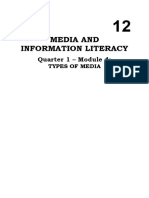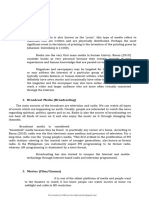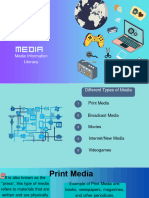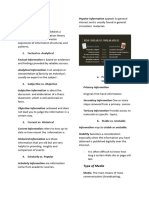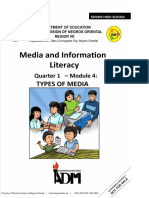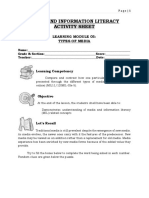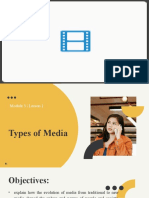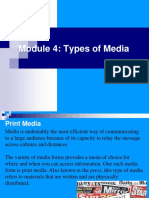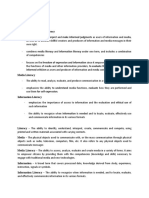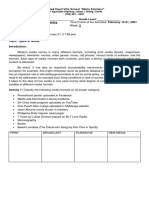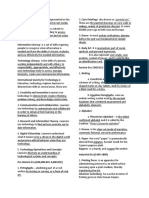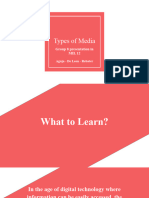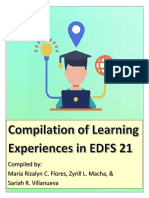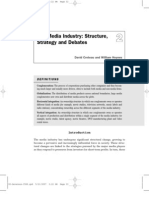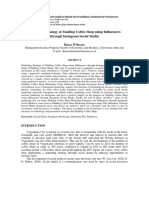Media and Information Literacy 12 – HUMSS
Quarter 1 – Module 4: Types of Media
Types of Media
1. Print Media
Print media is also known as the “press”, this type of media refers to materials that are
written and are physically distributed. Perhaps the most significant event in the history of
printing is the invention of the printing press by Johannes Gutenberg in (1440). This eventually
led to the mass production of books, which gave people an access to knowledge that they
never dreamt of during those times. Example of Print Media are: books, newspapers,
magazines, and other periodicals, manuscripts, correspondence, memoranda, loose leaf
materials, notes, and brochures.
Books are the very first mass media in human history. Baran (2010) consider books
as very personal because they contain records of past experiences and human knowledge
that are passed on to later generations. Books are movers and shakers of culture. As a
statement to this, books in physical form are being stored digitally as e-books. Magazines and
newspapers may be targeted for the general audience or may address the interests of a
particular group of readers.
Magazines typically contain features or human-interest articles, whereas newspapers
will definitely have news stories and occasionally have other types of articles. Both the
magazine and the newspaper may also have online versions for them to reach a wider and
larger audience who are more often virtually connected through the Internet.
2. Broadcast Media (Broadcasting)
The main sources of the broadcast are television and radio. We can watch all types of
events which are happening on earth. Usually, people are interested to watch the news
regarding spiritual, politics, sports and so on. Radio is also the source of broadcasting we can
hear all kinds of news on it and also enjoy the music on it through changing the channels.
Broadcast media is considered “household” media because they be found in practically
any corner of a home. According to Baran (2010), radio was the first electronic mass medium
and precursor of television. For a long time, radio was the “young people’s media. “This first
evident in the proliferation of FM radio stations catering to the musical taste of younger
generations, also known as format radio. In the Philippines, you customarily expect FM
programming to be format radio, whereas AM programming is dominated by a news format.
Broadcasting has also started to conquer the Internet and mobile technology through Internet-
based radio and television programmed.
3. Movies (Film/Cinema)
It is one of the oldest platforms of media and people went to the theaters to watch it
but know people can watch movies at home via safelight and cable in HD resolution. According
to Wikipedia, a film is created by photographing actual scenes with a motion picture camera;
by photographing drawings or miniature models using traditional animation; or by a
combination of some or all of these techniques and other visual effects. It is a series of images,
which when displayed on screen, create an illusion of moving images by the phi phenomenon.
Compiled by: Ms. Zyrill M. Quisquino Reference: Department of Education –Region VII Schools Division of Negros Oriental
� Media and Information Literacy 12 – HUMSS
Films are very important artifacts because, like books, they reflect the desires, ideologies, and
sensibilities of the culture to which they originate from.
4. Internet / New Media
The Internet is one of the newest sources of media. The majority of the users prefer
the internet to watch news quickly. It is more fast and capable in compare to any other source
of media. Internet changes the world and connects the people also deliver the users to keep
in touch with the latest inventions and news. The Internet also gives you a chance to express
your ideas all over the globe.
The internet and social media provide young people with a range of benefits, and
opportunities to empower themselves in a variety of ways. Young people can maintain social
connections and support networks that otherwise wouldn't be possible, and can access more
information than ever before. The communities and social interactions young people form
online can be invaluable for bolstering and developing young people's self-confidence and
social skills.
5. Video Games
Video games continue to grow popular to both young and old because of their
increased interactivity and interconnectivity. It is only grown in youth with high dimensions and
more graphics. Games are the form of electronic media devices. Now games are also
available on mobile phones and people are easily accessible to them.
What is Media Convergence?
Converge means to meeting at a point, it is synonymous to the words: join, unite,
interest, merge, connect, coincide. Media Convergence happens when different (two or more)
media sources join together. It allows media texts to be produced and distributed on multiple
media devices.
Media convergence is the ability to transform different kinds of media into digital code,
which is then accessible by a range of devices. Media convergence usually occurs in various
platforms such as:
1. Social Network
2. Learning Management System
3. Product Advertisement
4. News Agency
5. Multimedia Personality
Media convergence have a vital element of life for many people. With the development
of technology in different platforms and cooperation such as television, Internet and mobile
communication, audiences have had both a bigger choice of media and a life which media
technologies has made easier.
Compiled by: Ms. Zyrill M. Quisquino Reference: Department of Education –Region VII Schools Division of Negros Oriental
� Media and Information Literacy 12 – HUMSS
Compiled by: Ms. Zyrill M. Quisquino Reference: Department of Education –Region VII Schools Division of Negros Oriental
� Media and Information Literacy 12 – HUMSS
CLASSIFICATION OF MEDIA
There are different ways to classify media.
1. Print media, non-print media, electronic media
· Print media. They include: books, journals, magazines, newspapers, workbook, textbooks
· Non-print media: they include: projected and non-projected media
· Electronic media: they include: Audio media, Visual media and Audio-Visual
2. Projected media & non-projected media
· Projected media: they require light source for projection. E.g. film projector slides etc.
· Non-projected media: they do not require light source. They include 3 dimensional objects,
2 dimensional objects, prints, charts, models etc.
3. Audio media, Visual media & Audio-visual
· Audio media: this form of media carry sounds alone. E.g. audio tapes, record player,
· Visual media: These are the ones that can be seen. E.g. TV, computer, white board
· Audio-Visual: this term refers to those instructional materials which provide students with
audio and visual experiences by appearing to the hearing and seeing senses at the same
time. E.g. TV, video tapes, closed circuit television (CCTV).
4. Hardware and software
· Hardware: this the classification of machines or equipment used in the instructional
process. It is upon these gadgets that the software is transmitted. E.g. Television set, tape
recorder etc.
· Software: this classification consists of all materials used with the machine. They are the
real carrier of knowledge or information. They include, films, tapes transparencies.
Compiled by: Ms. Zyrill M. Quisquino Reference: Department of Education –Region VII Schools Division of Negros Oriental



